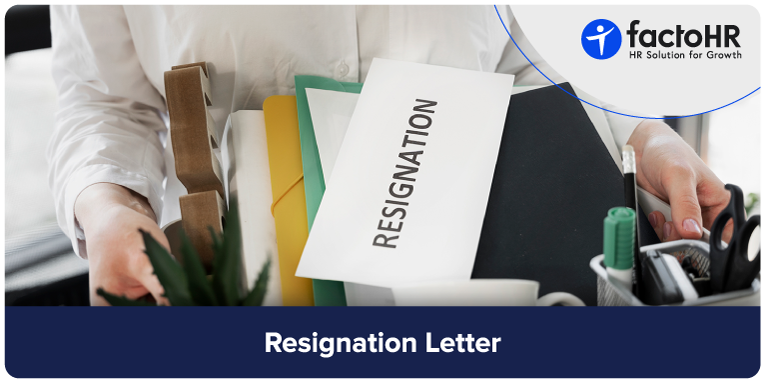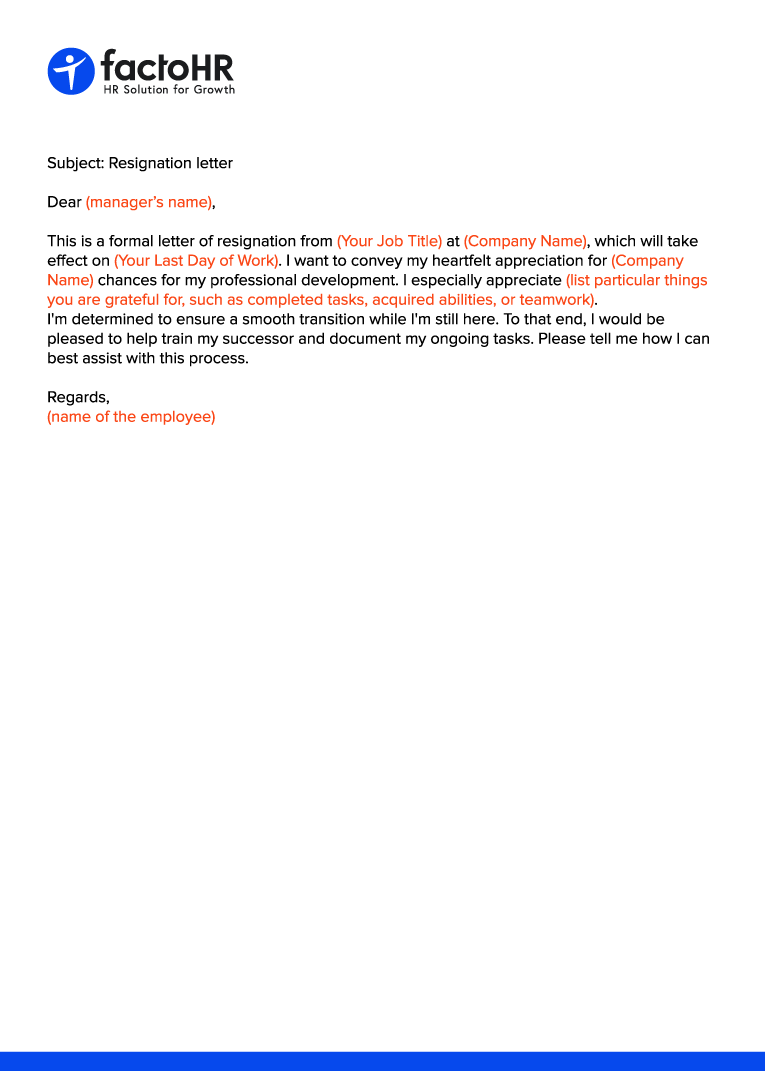Resignation Letter Format for Employees: Tips, Templates, and Examples

Download Standard Resignation Letter Format for Employees
Table of Contents
A resignation letter ensures a professional way for employees to communicate their intent to leave the job. Be it for pursuing a new career or taking personal retirement, a sound resignation letter helps one exit positively while maintaining good relations with the top.
This blog outlines resignation letter formats, provides tips for using letters, offers a sample, and offers templates for modification by employees. There is information available on writing resignation emails, accepting resignations, and communicating with HR.
What is a Resignation Letter?
A resignation letter is a formal letter that the employee has addressed to the employer in which the employee has indicated that he or she has decided to stop working in a firm or organization. It normally states the planned final working date and triggers the offboarding process. The letter is a formal written notice, which provides a very smooth and professional changeover.

Standard Resignation Letter Format for Employees
The typical resignation letter is organized in a manner consistent with business letter templates. Here is a standard format you can follow,

Sample of Resignation Letter for Employees
To,
The HR Manager
Xenia Pvt. Ltd.
Thaltej
Ahmedabad – 368100
Subject: Letter of Resignation
It is my pleasure to send you this notice of my resignation. I learned a lot and grew well at your prestigious organization. After the expiration of the notice period on 25 August 2025, the handover of company assets will be done, and I will provide full support.
Best Regards,
Sudama Patel
Best Samples of Resignation Letters with Examples
Here are variations of resignation letter formats employees can use depending on the situation:
1. Simple Resignation Letter Format Word
[Date]
To,
The HR Manager
[Company Name]
[Company Address]
[City, State, Zip Code]
I am informing your respected organization about my decision to resign. My decision is personal and has nothing to do with your organization’s policy. I am resigning from the post of (My Role) from the (Date). Please accept my resignation and convey the further process.
Thank you
Best regards,
[Your Name]
2. Job Resignation Letter with Notice Period
To,
The HR Manager
[Company Name]
[Company Address]
[City, State, Zip Code]
Dear sir/mam
I have decided to resign from the (Position) effective as of (Date). Please accept the resignation and state the further process of onboarding. Additionally, I will serve my notice period as per company policy and assist with the handover process.
Thank you for your support.
Sincerely,
[Your Name]
3. Email Format
To,
The HR Manager
[Company Name]
[Company Address]
[City, State, Zip Code]
Subject: Letter of Resignation
Dear sir/mam,
I am resigning from my position at [Company Name], effective [Last Working Day]. I appreciate all the support and opportunities I’ve received during my tenure.
Best regards,
[Your Name]

Resign Letter to HR Format
To,
The HR Manager
[Company Name]
[Company Address]
[City, State, Zip Code]
Subject- Notice of Resignation
Dear sir/mam,
I resign from my position at [Company Name] with effect from [Last Working Day]. Please start the exit management process and inform me of the clearance formalities.
Thank you for helping out.
Sincerely,
[Your Name]
Acceptance of Resignation or Approved Application
Human Resources managers and supervisors often insist that they receive a formal acceptance letter when the employee resigns. Here is a sample,
[Recipient’s Name]
[Recipient’s Job Title]
[Company Name]
[Company Address]
[City, State, ZIP Code]
Subject: Acceptance of Resignation:
Dear [Employee’s Name],
We received your resignation letter. Our esteemed organization recognizes your contribution to the position of (Job Title). The resignation is accepted as of the date (Resignation Date). Your last day of work will be (Date)
All The Best,
[Manager’s Name]
[Title]
[Company Name]
The Significance of a Resignation Letter
The resignation letter is primarily needed to document the decision to resign, provide a clear timeframe for transition, and maintain good professional relationships. It can be used to resolve any dispute by simply producing the official record. It eases the handover process for both the team and management, providing a record for future reference.
Professional Record
The letter is an official document that provides notice of intent to quit and the final working day, which employers retain due to HR and legal considerations. A copy will also serve as protection for both parties during the delivery of the notice, and any terms can be specified.
Clarity and Timelines
Writing down the resignation minimizes misunderstandings on what is expected on the last day, the notice period, and the handover, thus enabling managers to plan for placement and redistribute the work. Written schedules provide a smoother transition process and reduce the disruption of the project.
Relationship Management
A considerate letter is a sign of professionalism and respect, which helps sustain goodwill, references, and a good image in the industry even after leaving. Expressing gratitude in a positive tone will help in networking over time and facilitate possible collaboration with former coworkers.
Negotiation and Feedback
When providing brief reasons, you can encourage positive responses from employers, such as counteroffers, changes to your role, or adjustments to existing processes based on your exit feedback. While the intention is not to leave, the letter frames the situation positively and avoids mentioning grievances that could damage your reputation.
Alignment of Policies and Processes
Several employers require written notice, typically outlined in contracts or HR policies. One of the best ways of meeting such procedural requirements is by submitting a letter. Also, it is a best practice to issue a written notice, even where it is not a mandatory practice in a policy.
Handover and Continuity
Assuming readiness to help in transition, knowledge transfer, documentation, or training sets expectations and limits risks to continuity. Such a proactive approach is a sign of reliability and leaves a positive impression, especially when an employee is leaving.

How to Write a Professional Resignation Letter
A well-written resignation letter should be in a positive tone. It is essential to present your terms professionally.
Essential Components
All good resign letters must cover certain key aspects to be perceived as clear and professional.
| Component | Purpose |
|---|---|
| Date | Provides a formal record of when the resignation was submitted. |
| Recipient Details | Ensures the letter is addressed to the appropriate manager/HR personnel. |
| Opening Statement | Clearly states the intent to resign and the effective date of resignation. |
| Notice Period Mention | Confirms compliance with the company’s required notice period. |
| Reason for Resignation | Optionally provides a polite, concise explanation (without negativity). |
| Expression of Gratitude | Acknowledges positive experiences and opportunities provided by the company. |
| Offer of Transition Help | Shows professionalism by offering assistance during handover. |
| Closing Formalities | Ends the letter with a polite sign-off and readiness for a smooth transition. |
| Signature | Adds authenticity and formal approval to the resignation. |
Writing Best Practices
The letter should always maintain a professional tone, regardless of the reasons for your departure. Keep it brief and to the point, without providing unnecessary details or criticizing others or the organization.
Here are some of the other major practices to follow
- Hand it over personally: Discuss your decision with your manager face-to-face and then hand them the letter.
- Include contact details: Put your contact information at the top.
- Add the date: When the letter was submitted/written.
- Name the company: The letter should be adequately addressed to the company.
- Put a straight-to-the-point subject line: In case of sending an email, a straight subject line like ‘Resignation – [Your Name]’ is the most suitable one.
- Sign a professional way off your letter: ‘Sincerely’ or ‘Best regards’ are recommended to use at the end of your letter.
What to Avoid
Do not voice grievances, complaints, or negative feedback in your resignation letter. Also, do not discuss confidential information or disclose excessive information about personal reasons that led to the decision.
Here are other key things to avoid,
- Writing in haste without proofreading.
- Over-explaining personal reasons
- Forgetting to include your last working day.
- Using casual or negative language.
- Submitting without giving a proper notice period

Conclusion
It is essential that a professional resignation letter creates an accurate record and presents clear information. The employee will identify their last day of employment, and communicate on many other main issues.
Regarding the Human Resources department, the letter captures the employee’s reason for resigning and provides an overview of the entire situation.
FAQ
What Should the Format of the Resignation Letter by an Employee be?
A professional resignation letter will have a true legitimate header of your contact details, date, and address of the recipient with a formal salutation. The resignation will definitely be stated, the last day of work (usually two weeks after submission) will also be mentioned, thanks will be given, and readiness to cooperate in the transition will be expressed.
Is It Possible to Use an Email Template of a Resignation Letter in Place of a Letter?
Yes, indeed. Emails of resignation are largely accepted and have become the norm in place of printed letters being sent. However, there are organizations that believe resignation must always be in written form, typically in a letter.
What is a Short Resignation Letter?
A short resignation letter is a formal resign letter mentioning your position, your last day at work, a thank-you note, and an offer to help. Usually, the letter with three or four brief sentences and with the proper issues mentioned is short and formal in style.

Modernize your HR tasks with factoHR today
Experience the digitalization of everyday business activities with factoHR's modern and compatible solutions for every need.

© 2025 Copyright factoHR


